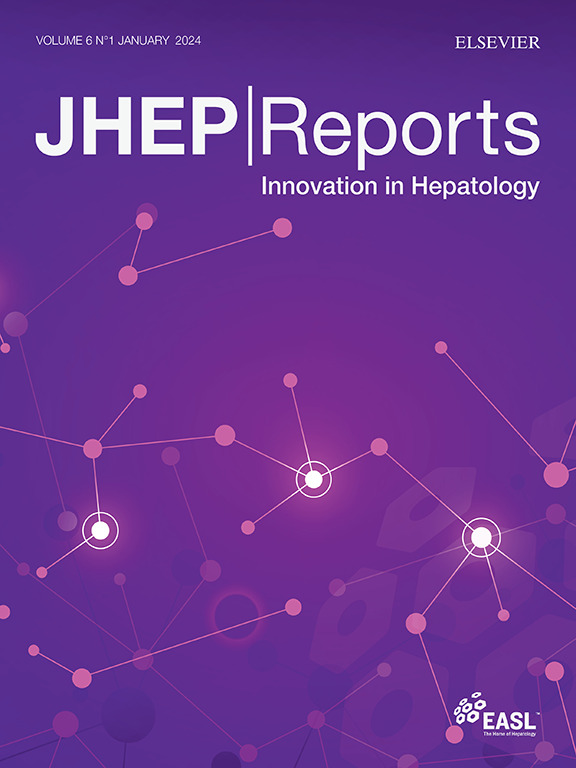Deep learning can predict cardiovascular events from liver imaging
IF 7.5
1区 医学
Q1 GASTROENTEROLOGY & HEPATOLOGY
引用次数: 0
Abstract
Background & Aims
Cardiovascular mortality remains the leading cause of death and a significant source of morbidity, with metabolic alterations being key etiological factors. As the main metabolic organ, the liver could predict prodromal changes associated with increased cardiovascular risk. However, quantifying this risk remains challenging. This study explores the use of transformer neural networks on liver magnetic resonance imaging (MRI) data to enhance cardiovascular risk prediction.
Methods
Using the extensive collection of liver MRIs in the UK Biobank, we developed a feature extractor with a vision transformer backbone trained in a self-supervised manner. This encoder was then used to predict cardiovascular outcomes from liver MRI scans. Unlike traditional methods, no manual feature selection was required, minimizing bias. Performance was assessed via fivefold cross validation, where predicted risk scores were compared against actual cardiovascular outcomes.
Results
The model was trained on 44,672 liver MRIs. In the fivefold cross-validation predicting major adverse cardiac events, the mean AUC was 0.70 with a 95% CI of 0.69–0.72 and p <0.001. The F-statistic from the one-way ANOVA comparing the Systematic Coronary Risk Evaluation 2 (SCORE2) values of the three prediction model score groups was 68.49 with p <0.001. The log-rank test comparing the survival of those with prediction model scores above and below 0.5 had a test statistic of 43 and p <0.001. The multivariate log-rank test comparing the survival of those in the four quartiles of prediction model scores had a test statistic of 61 and p <0.001.
Conclusions
Vision transformer-based models demonstrate promise as quantifiable biomarkers for cardiovascular risk assessment by capturing subtle metabolic and vascular information from liver MRI scans. These findings highlight their strong predictive performance and potential value in risk stratification. Further prospective studies and external validation will be required to establish their clinical utility.
Impact and implications
Our study demonstrates that deep learning applied to liver MRI can predict cardiovascular risk, highlighting the role of the liver as a metabolic indicator of early cardiovascular disease. These findings are significant for clinicians and researchers seeking non-invasive, imaging-based biomarkers for cardiovascular risk stratification, particularly in patients who might not yet exhibit overt symptoms. If validated in prospective studies, this approach could enhance current risk assessment models, allowing for earlier and more personalized interventions in high-risk individuals. However, further validation is necessary before clinical implementation, ensuring broad applicability and integration into existing prevention frameworks.

深度学习可以通过肝脏成像预测心血管事件
背景,心血管死亡仍然是主要的死亡原因和发病率的重要来源,代谢改变是关键的病因。肝脏作为主要的代谢器官,可以预测与心血管风险增加相关的前驱变化。然而,量化这种风险仍然具有挑战性。本研究探讨了变压器神经网络在肝脏磁共振成像(MRI)数据上的应用,以增强心血管风险预测。方法利用英国生物银行收集的大量肝脏核磁共振成像数据,我们开发了一种带有视觉变压器骨干的特征提取器,该骨干以自我监督的方式训练。该编码器随后用于预测肝脏MRI扫描的心血管结果。与传统方法不同,该方法不需要手动特征选择,从而最大限度地减少了偏差。通过五倍交叉验证评估表现,将预测风险评分与实际心血管结果进行比较。结果该模型对44672张肝脏mri进行了训练。在预测主要心脏不良事件的五重交叉验证中,平均AUC为0.70,95% CI为0.69-0.72,p <0.001。比较三个预测模型评分组的系统性冠状动脉危险评价2 (SCORE2)值的单因素方差分析的f统计量为68.49,p <0.001。log-rank检验比较预测模型得分高于和低于0.5的患者的生存率,检验统计量为43,p <0.001。多变量log-rank检验比较预测模型评分四个四分位数患者的生存率,检验统计量为61,p <0.001。基于视觉转换器的模型通过从肝脏MRI扫描中获取微妙的代谢和血管信息,证明了作为心血管风险评估的可量化生物标志物的前景。这些发现突出了它们强大的预测性能和潜在的风险分层价值。需要进一步的前瞻性研究和外部验证来确定其临床应用。影响和意义我们的研究表明,深度学习应用于肝脏MRI可以预测心血管风险,突出了肝脏作为早期心血管疾病代谢指标的作用。这些发现对于寻求无创、基于成像的心血管风险分层生物标志物的临床医生和研究人员具有重要意义,特别是对于尚未表现出明显症状的患者。如果在前瞻性研究中得到验证,这种方法可以增强当前的风险评估模型,允许对高风险个体进行更早和更个性化的干预。然而,在临床实施之前需要进一步验证,以确保广泛的适用性并融入现有的预防框架。
本文章由计算机程序翻译,如有差异,请以英文原文为准。
求助全文
约1分钟内获得全文
求助全文
来源期刊

JHEP Reports
GASTROENTEROLOGY & HEPATOLOGY-
CiteScore
12.40
自引率
2.40%
发文量
161
审稿时长
36 days
期刊介绍:
JHEP Reports is an open access journal that is affiliated with the European Association for the Study of the Liver (EASL). It serves as a companion journal to the highly respected Journal of Hepatology.
The primary objective of JHEP Reports is to publish original papers and reviews that contribute to the advancement of knowledge in the field of liver diseases. The journal covers a wide range of topics, including basic, translational, and clinical research. It also focuses on global issues in hepatology, with particular emphasis on areas such as clinical trials, novel diagnostics, precision medicine and therapeutics, cancer research, cellular and molecular studies, artificial intelligence, microbiome research, epidemiology, and cutting-edge technologies.
In summary, JHEP Reports is dedicated to promoting scientific discoveries and innovations in liver diseases through the publication of high-quality research papers and reviews covering various aspects of hepatology.
 求助内容:
求助内容: 应助结果提醒方式:
应助结果提醒方式:


